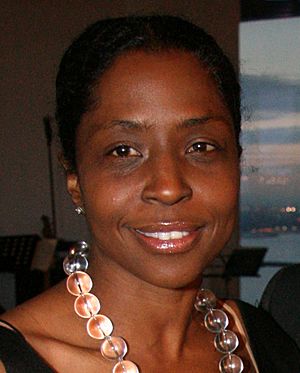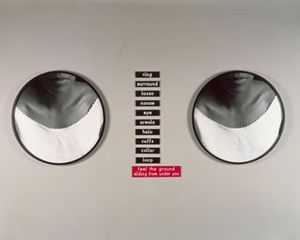Lorna Simpson facts for kids
Quick facts for kids
Lorna Simpson
|
|
|---|---|

Simpson in April 2009
|
|
| Born |
Lorna Simpson
13 August 1960 Brooklyn, New York
|
| Nationality | American |
| Education | University of California-San Diego, MFA, 1985; School of Visual Arts, New York City, BFA, 1983 |
| Known for | Photography, Film, Video |
| Movement | Conceptual photography |
| Awards | 2010 ICP Infinity Award in Art, International Center of Photography, New York City; 2019 J. Paul Getty Medal |
Lorna Simpson (born August 13, 1960) is an American photographer and artist who uses many types of media, like film and video. Her art has been shown in famous galleries all over the world. In 1990, she was one of the first African-American women to show her art at the Venice Biennale, a major international art show.
Simpson became well-known in the 1980s and 1990s. She created artworks that combined photos with text. These pieces, like Guarded Conditions, made people think about big ideas like identity, gender, and race. She continues to explore these themes using photography, film, painting, and even sculpture.
Contents
Early Life and School
Lorna Simpson was born in 1960 and grew up in New York City. Her parents loved the arts and took her to see plays, museums, and concerts. This inspired her to become an artist. She went to the High School of Art and Design and also took summer classes at the Art Institute of Chicago.
After high school, Simpson traveled around Europe, Africa, and the United States, taking pictures and improving her skills in documentary photography. She earned her first art degree from the School of Visual Arts in New York City in 1983. While studying, she worked at the Studio Museum in Harlem, where she learned from the artist David Hammons.
Later, she got her Master of Fine Arts degree from the University of California, San Diego in 1985. There, she developed her unique style of art. She took studio-style photos and added words to them. Her art questioned whether photos show the complete truth or just the version the photographer wants to show. Her work often explored the stereotypes about African-American women in American culture.
Artistic Career
In 1985, Simpson won an important award from the National Endowment for the Arts. Her career grew quickly, and in 1990, she showed her work at the Venice Biennale. That same year, she became the first African-American woman to have her own solo show at the Museum of Modern Art in New York.
Throughout her career, Simpson has received many awards and honors. Her work has been featured in museums across the United States and Europe. In 2007, the Whitney Museum of American Art in New York held a major show looking back at 20 years of her art.
Simpson has also worked on other creative projects. In 2016, she designed the album cover for the rapper Common's album Black America Again. In 2017, she took powerful portraits of 18 creative women for Vogue Magazine.
Her work is part of the Before Yesterday We Could Fly exhibit at the Metropolitan Museum of Art. This exhibit explores ideas of Afrofuturism, which mixes science fiction with African history and culture.
Even though she started as a photographer, Simpson now works with many different art forms. She wants to inspire the next generation of Black artists. When asked about her career, she said, "I've always done exactly what I wanted to do... I just stuck to that principle and I'm a much happier person as a result."
Exploring Themes in Her Work
Simpson's art often features Black women and uses text to explore ideas about race and gender. In many of her early pieces, the faces of her subjects are hidden or turned away. This makes the viewer think more deeply about the person's identity instead of just their appearance. By hiding the face, she challenges the viewer and refuses to let them easily categorize the person in the photo.
Famous Artworks

2 gelatin silver prints and 11 engraved plastic plaques, 40 x 100 in.,
National Gallery of Art, Washington, DC
- Necklines (1989): This piece shows close-up photos of a Black woman's neck and collarbone. Next to the photos are words on plaques, such as "ring," "lasso," and "collar." The final phrase, "feel the ground sliding from under you," suggests great danger and violence. The calm images next to these threatening words create a powerful and unsettling feeling.
- Easy for Who to Say (1989): This work shows five identical outlines of a Black woman. Their faces are covered by ovals with the vowels A, E, I, O, U. Below them are the words: Amnesia, Error, Indifference, Omission, Uncivil. The artwork suggests how the history and experiences of people of color can be forgotten or ignored.
- Guarded Conditions (1989): In this piece, Simpson uses a series of Polaroid photos of a woman seen from behind. By showing the body in separate parts, she makes the viewer think about how Black women have historically been treated like objects rather than as whole individuals. The repeated poses suggest a feeling of being trapped or vulnerable.
- Wigs (1994): Instead of people, this artwork shows many different wigs, from afros to braids to blonde hair, all laid out like scientific samples. By not including any figures, Simpson makes the viewer think about beauty standards and how society's ideas of beauty affect people, especially Black women and their natural hair.
- Corridor (2003): This is a video installation that shows two women from different time periods: a household servant from 1860 and a wealthy homeowner from 1960. Both characters are played by the same artist, Wangechi Mutu. The video doesn't have a clear story. Instead, it creates a mood and encourages viewers to think about the connections between the past and the present, especially regarding race and class in America.
Personal Life
Lorna Simpson was married to fellow artist James Casebere from 2007 to 2018. They have a daughter named Zora. Simpson works in a studio at the Brooklyn Navy Yard.
Recognition
Simpson has won many awards for her art. Here are some of them:
- 1985 – National Endowment for the Arts Fellowship
- 1990 – Louis Comfort Tiffany Award
- 1997 – Artist-in-Residence Grant, Wexner Center for the Arts
- 2001 – Whitney Museum of American Art Award
- 2014 – Shortlisted, Deutsche Börse Photography Prize
- 2019 – Winner, J. Paul Getty Medal
List of works
- Stereo Styles. 1988. ten instant film pictures placed on engraved plastic. private collection.
- ID. 1990. Pérez Art Museum Miami.
- Back. 1991. 2 colour Polaroids and 3 plastic plaques.
- Counting. 1991. photogravure and screenprint. Minneapolis Institute of Art.
- Five Day Forecast. 1991. 5 photographs, gelatin silver print on paper and 15 engraved plaques. Tate Modern, London.
- Untitled (What should fit here...). 1993. photo-etching, screenprint and hand-applied watercolor. Minneapolis Institute of Art.
- lll (Three Wishbones in a Wood Box). 1994. wooden box containing three wishbones made of ceramic, rubber and bronze inserted in two felt pads. Minneapolis Institute of Art.
- The Waterbearer. 1996. silver print.
- Still. 1997. Pérez Art Museum Miami
- Wigs (Portfolio). 1994. portfolio of twenty-one lithographs on felt with seventeen lithographed felt text panels. Museum of Modern Art, New York City.
- Gestures/Reenactments. 1985. 6 photographs of a black man in white clothes, with text captions underneath.
See also
 In Spanish: Lorna Simpson para niños
In Spanish: Lorna Simpson para niños


